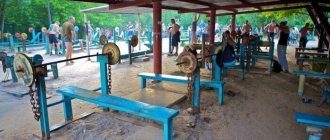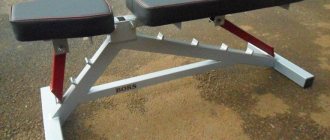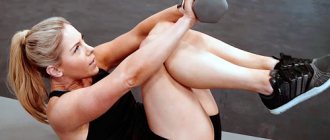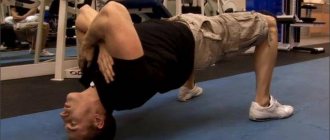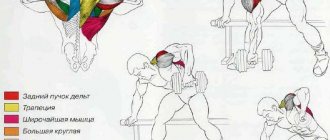Box jumps are effective for improving overall athleticism, but the big problem is that many people do this exercise incorrectly. Zozhnik translated an article by fitness expert Eric Bach on how to properly perform box jumps so that they actually bring benefits and do not destroy your joints.
To get even stronger, you need to get faster and develop explosive power, and the fastest way to develop it is to do box jumps.
Jumping is a great indicator of your explosiveness, athleticism, and relative strength, which is essential for almost any sport. And, yes, jumping will help you improve your body composition. The only problem is that they are advised to do too many and they are often performed with terrible technique.
Most of the impressive box jumps you see aren't really what they are. A 14 year old boy jumping onto a 137 cm tall box looks impressive, but in reality it is just a well-trained jump and excellent hip mobility, not pure explosive power. It’s even worse when people perform such pseudo-jumps. They don’t know how to land correctly and get injured.
Like any other exercise, box jumps are a training tool that should be handled with care and not just thoughtlessly thrown into your training program.
Three types of training for fighters
These sets of exercises are known and actively used by different schools of hand-to-hand combat. Athletes train in the gym under the supervision of a coach. After a year of classes, students train for wrestling and significantly increase the speed of their movements. The program contains a set of exercises:
- “Explosive” techniques with sports equipment – jerks, pushes. Over time, the fighter's movement speed increases.
- Stretching muscles using weights. Heavy projectiles increase the load.
- Support weight with legs or arms. The exercise helps strengthen the muscles that support the legs or arms during impact.
Detailed analysis of exercises
Training for MMA fighters is aimed at three muscle groups:
- Exercises for shoulders, chest, triceps.
- Workouts for biceps, back, rear deltoids.
- Exercises to strengthen your legs.
Athletes train at speed.
Analysis of exercises workout No. 1 (chest, shoulders, triceps, perform as usual):
- Bench press with dumbbells – 6 approaches (the number of repetitions is reduced from 15 to 4).
- Bench press in a lying position on an incline bench (3 x 10).
- Lifting the barbell from the hip to the chest (3 x 10).
- Standing press (military) (3 x 10).
- Dips (3 x 10).
- Raising the torso (2 x the maximum number that the athlete can perform).
After each approach, you need to rest for 3 minutes with proper breathing. Take a deep breath in through your nose and exhale relaxingly through your mouth.
Workout Exercises #2 (Back, Biceps, Rear Deltoids):
- Deadlift (3 repetitions x 10 exercises are enough).
- Lifting the barbell while standing. Biceps exercise (3 x 10).
- Bent-over dumbbell row (3 x 10).
- Pull-ups on the bar (3 x 10).
- In a hanging position, leg raises (2 x the maximum number the athlete can perform).
Training No. 3 (strengthening legs):
- Leg press (task: do 3 repetitions of 10 exercises).
- Snatches with lunges (3 x 10).
- Lying on a leg curl machine (3 x 10).
- Standing, raising on toes (3 x 10).
- Squats (3 x 10).
- “Jackknife” (2 x the maximum number that the athlete can perform).
Practicing striking techniques
An important key to the successful completion of a fight is a correctly placed blow. Regular practice of single variations of strikes, as well as combinations, contributes to their correct execution. Several weeks of training will lead to the desired effect. The main thing is the systematic implementation of training complexes for muscle development, using gradual weights.
A fighter’s striking training includes exercises on the bag, “paws”, sparring, working with partners, etc. At home, athletes can train on the “shadow boxing” principle. During the lessons, elements of defense and attack are learned. No real partner is used.
A fighter, when using the “shadow boxing” technique, works out the technical actions that he will use during fights. Exercises are performed at a fast and explosive pace. The fighter's maneuverability and speed of strikes increases.
When conducting combat sets with an imaginary opponent, they often use any equipment - weights or dumbbells. Their use allows you to quickly achieve the desired effect.
You also need to hit the air at a slow pace. Such exercises will allow you to identify technical sins and determine the degree of stability, and understand the reasons for imbalance.
An exercise in the form of “shadow boxing” allows you to choose a strategy for the upcoming fight if the athlete competes as a professional/amateur.
Be sure to focus on proper breathing. Do not forget that the athlete’s health, his well-being, and, consequently, the result of the fight in the form of victory depend on the freedom of inhalation and exhalation.
I discussed the topic of plyometrics in as much detail as possible in one of my articles. We talked about its significance in various sports, paying special attention to the processes that occur in the body and muscles when performing plyometric exercises. Here I would like to briefly draw attention to the fact that plyometrics in boxing acts as a foundation when performing any general or special exercise.
What is plyometrics - briefly
Plyometrics is a set of exercises aimed at improving muscle skill, which consists of quickly moving from peak contraction to a state of complete relaxation, and vice versa. I have already said why this is needed and how it affects muscle development. As an example, we can only recall jumping. By imagining this movement, you will understand what is happening to the muscles. However, we will also talk about jumping below.
I said that the maximum effect of plyometric exercises is achieved not only due to the maximum amplitude of muscle contraction and relaxation. The duration of this contraction is very important here. That is, the muscles must learn to develop maximum impulse in the shortest possible period of time.
Plyometrics and boxing
All punches in boxing are pure plyometrics. The moment of the beginning of the blow consists of maximum local and consistent muscle tension, which continues only in the first phases. At the moment the fist flies, the muscles of the arm and other working groups relax. When colliding with the target, a contraction occurs again, but it is, as it were, forced. But this does not change the essence, and at this moment the muscles must mobilize again. And the force of the blow largely depends on this phase. But we'll talk about this another time.
I mean, what's going on? Explosive force with contraction-relaxation-forced contraction. In part, this is how a spring would work, which was first compressed, and the energy accumulated during this compression would push its part forward. But what would happen if this energy were extinguished not due to the natural straightening of the spring, but through a collision with an obstacle? That's right, the impulse from the collision would go through the spring in the opposite direction. But, perhaps, this example will also be good for another topic, when we talk about the moments of maximum impact force.
In this case, the example is good to show more clearly what happens after an explosive volitional and forced contraction. Now remember that muscles can adapt to load, so with the help of plyometric exercises we can make our spring more explosive and stronger.
It seems to me that I explain things very clearly, and for some reason this makes me happy. But let's continue.
Boxing exercises
I will not list the entire arsenal of existing boxing exercises, and it is unlikely that this will be possible. We will consider only the basic ones, and as an example we will use those that were given as components of the circuit training complex. Moreover, let me remind you that these are the exercises that were used back in the Soviet boxing school.
Jumping over a bench and onto a pedestal
Everything is clear with jumping. Minimum touch time, fast execution. And jumping on a pedestal was even called depth jumping. And at this point I want to emphasize the importance of jumping, when the leg muscles relax, and then a forced contraction occurs when they collide with the surface. And at this moment the muscles should be able to quickly extinguish the inertial impulse and just as quickly “shoot” the body back up.
And again, if you imagine a spring flying down, what happens to it? She stretches out. The muscles are stretched in the same way.
Impacts with an expander or in a block simulator
Here, almost the same thing happens as during an impact, and we have already figured out that an impact is a manifestation of plyometrics in its purest form. When working with resistance, the load increases at the moment of explosive muscle contraction. Ultimately, local hypertrophy of muscle fibers occurs, and a subjective feeling of “light hands” comes. This is the same as getting used to doing pull-ups on a horizontal bar with weights, and then trying without. In general, the definition of “ballast” most directly fits here.
Standing barbell throw
Well, here, too, everything is clear: the upper shoulder girdle works, the muscles become accustomed to the characteristic pushing impulse, but at the same time, in the final phase, an additional load arises in the form of inertial movement of the barbell, and you have to make additional efforts to hold it and return to the starting position. As a result, there are two main zones for contraction - initial and final, and in the interval the muscles relax (the coils of the spring stretch freely).
Medicine ball exercises and shot put
If you throw something, no matter how you throw it, you are using the contractile-extension function of the muscles. The weight of the medicine ball makes this task more difficult. And it doesn’t matter whether you throw it with one or two hands - in any case, the action is directly related to plyometrics. In this case, the biomechanics of movements will be close to boxing.
In the case of the kernel, everything is even clearer. The core is heavy and requires maximum explosive impulse in the initial phase. At the moment of lifting from the hand, a sharp relaxation of all muscles occurs. In addition, the core can be compared to the same ballast. The exercise gives an amazing result; when performed correctly and regularly, the impact force increases significantly.
The throwing movements must be made from a fighting stance and correspond to the movements when striking. This applies to both the front and back hands.
Working with a sledgehammer
I did not consider this exercise, citing the example of constructing a circuit training. It’s just that that article turned out to be too long, and the list of exercises for boxing could be listed for a very long time.
The blows with a sledgehammer are applied to the lying wheel. This work may seem too simple to some, but it will quickly pass. Literally after a few quality hits. I think it will be superfluous if I start to analyze this exercise into phases of contractions and relaxations - the essence is already quite clear. I cite it as an example only to show that the presence of plyometrics in boxing is clearly reflected here.
Afterword
I hope I conveyed the point clearly. I could talk here about pull-ups, deep squat jumps, dips and push-ups, as well as any exercise that involves using your own weight and is used in any type of contact martial arts.
If the same push-ups or pull-ups are complicated by briefly depriving the arms of support points in a certain phase, the functional exercise will increase in its level of efficiency, thanks to the elements of plyometrics. For example, this could be push-ups with clapping. And what is the jump rope friend known to all boxers worth?
Remember the classic burpee and analyze the movements in it. It’s not for nothing that this is a basic exercise in CrossFit.
In any case, all of the above exercises are based on a plyometric base, and plyometrics in boxing are one of the main keys to progress.
In the video you can see the running technique of a cheetah. Its biomechanics are based on plyometric principles. Please note: maximum stretch-shortening. Strong spring.
Plyometrics
is the scientific name for training that involves jumping and jumping movements. Track and field athletes use plyometrics to improve performance such as speed and endurance, and ultimately their athletic performance.
If you need to increase boxing speed and explosive power, then plyometrics are also necessary.
Inventory/Equipment for CrossFit
CrossFit is a unique sport in which there is no specialization. While practicing CrossFit in specialized CrossFit gyms or simply watching videos about this sport, you have probably noticed a huge amount of sports equipment and equipment. Why is it necessary? It’s simple, the point is to diversify the training process as much as possible, expose your body to all kinds of physical activity and uniqueize the upcoming workout so that it differs from previous ones, because this is the essence of CrossFit training.
Thanks to such training, you will always be ready for almost any extreme life difficulties in everyday life. Below are the most popular CrossFit sports equipment and equipment that are widely used in CrossFit
Abmat (Abmat) is a special “pillow” equipment. It is designed to ensure the most comfortable performance of abdominal exercises. Due to its shape, Ambat creates a greater load on the abdominal muscles and stretches them, and also reduces the load on the spine (due to the natural deflection of the lumbar region) to prevent various injuries and increases the effectiveness of the exercise.
Abmat
Box jump - boxes in CrossFit are used for leg training. With the help of the stand you can perform various exercises, such as: walking, jumping, jumping and so on. With these exercises you can train your agility, explosiveness and coordination.
Box jump (Tumba)
The EMS trainer (suit) is an electronic power vest that can be used as an alternative to the gym right at home and beyond. Thanks to the impulse effect on the muscles, just 20 minutes of training in a vest will replace several hours of intense work in the gym.
Ems training suit
The GHD machine is a special bench for training the core, hamstring and gluteal muscles, as well as the muscles that straighten the spine. This machine is popular in CrossFit, and athletes often include it in their workouts due to its simplicity and effectiveness.
GHD-trainer-(Roman-chair)
Dumbbells are a common sight in CrossFit. This is one of the most popular items in various strength sports. They are used to work out various muscle groups and train physical qualities. There are many exercises with dumbbells in CrossFit such as: Farmer's walk, Turkish GetUp, Jumping Squats, Dumbbell Split Clean and Dumbell Snatch tri-panel.
Dumbbells
The kettlebell is one of the important components in CrossFit training. This equipment allows you to train explosive strength, power and endurance. Experienced athletes and trainers advise combining strength training with kettlebells, since simply kettlebell lifting by itself is ineffective. Hence kettlebell lifting received great sympathy in CrossFit.
Kettlebell
Rope – in CrossFit it is used for more functional training. Cable training differs from strength training in that you work large muscle groups for as long as possible. That is, in simple terms, you create a constant load on your muscles. Thanks to the rope you will be able to: train the muscles involved in gripping, increase your endurance level, and also develop good stability and balance.
Rope
Gymnastic rings are one of the most ancient and universal equipment. It is believed that training with unstable sports equipment is more effective than exercise in a simulator. Rings allow you to develop important physical qualities of the whole body, such as flexibility, endurance, coordination and strength. All of these qualities are very important for athletes who engage in CrossFit.
Gymnastic Rings
Med Ball is a special stuffed ball with sand that is used for intense CrossFit training. Thanks to the exercises in which you can use MedBol, you train and work out the main muscle groups, and also develop explosive strength and speed of movement. Another advantage of MebdBol is that exercising with it does not put much strain on the joints.
MedBall
A sandbag is a bag usually with three pouches that are designed to hold sand. With this equipment you can perform a wide variety of exercises for the whole body. The Sandbag can be used in place of a variety of gear, but what makes it unique is that it has a constantly changing center of gravity due to the pouches moving around in the bag. This makes the exercise more difficult and adds variety to the training process.
Sandbag
Resistance loops have become very popular in CrossFit due to their many uses. Thanks to the loops, you will be able to practice punches (developing explosiveness and speed), and learn to do pull-ups or push-ups faster. They serve as a good way to stretch the muscles of the entire body after strength training, and they can also be used as additional weighting material.
Rubber Loops
Jump Rope – Speed jump ropes are becoming increasingly popular in CrossFit. They are unique in that they are made of light and thin steel cable with special ergonomic handles, due to this, you can perform the exercise much faster and put less strain on your hands and forearms. This is an excellent way to diversify your cardio workouts; jumping rope can even rival running in its effectiveness.
Jump Rope
The power rack is a widely used piece of equipment in CrossFit for compound training. It has a lot of useful functions for progressive training. With it you can perform various exercises (using additional equipment), for example: pull-ups, squats, use for bench presses, etc. While developing almost all parts of the body.
Power Hour
The wall pull-up bar is another great piece of equipment for developing upper body muscles. It is widely used both at home and in various CrossFit gyms. You can find several applications for it in CrossFit, such as working out the back (through pull-ups), various exercises for the press (by doing leg or body lifts), and also for developing arm muscles.
Wall Horizontal Bar
Push-up supports are a sports equipment that is widely used in various sports. Thanks to push-up supports, you can increase the range of motion during push-ups and thereby increase the return rate of the exercise. They are used in fitness, bodybuilding, CrossFit and more. Due to their compactness, they are also suitable for practicing at home.
Push-up supports
The barbell is probably one of the most used equipment in CrossFit, since there are many exercises and variations to them with the barbell. Not a single CrossFit competition is complete without this equipment. The barbell is used to work out almost all muscle groups and develop various physical qualities. This is truly an indispensable piece of equipment in CrossFit and other strength sports.
Barbell
A rowing machine is equipment that is found in almost any gym. It is used in both Bodybuilding and CrossFit. In CrossFit training, it is often used to effectively train the respiratory, cardiovascular and cardiovascular systems. Exercises on this simulator allow you to develop endurance, strength, and also increase your overall tone.
Trainer for Rowing
CrossFit Sled - Used primarily as a weighted weight for running or as a pushing object with plates, where the pulling and pushing muscles of the entire body are involved. This is an excellent piece of equipment for strength and cardio exercises that will strengthen your core and explosive leg strength, as well as various core and core stabilizer muscles.
Sledge (Sledge Crossfit)
Methodology
Plyometrics
(or, in other words, the “impact method”) as a technique was developed
by Yuri Verkhoshansky
, who participated in the training of weightlifters, track and field athletes, speed skaters and other athletes of the Soviet Union national team at the turn of the 60s and 70s.
He discovered that when jumping or running, a lot of force is used in a short period of time (contact with the ground when jumping is 0.2 seconds, and even less when running - 0.1 seconds).
Hence the conclusion: to improve performance, an athlete must develop the ability to make a large effort very quickly.
The best exercise that creates brief contact with the ground was the depth jump. The jump is made from a certain height (50-70 centimeters) with an instant jump up. It is very important that landing and jumping are done as quickly as possible, in 0.1-0.2 seconds.
The essence of a deep jump is this: when an athlete falls from a height, he gains kinetic energy, and upon landing, the muscles of the thigh and lower leg contract eccentrically to slow down the fall. The eccentric contraction is then followed by an isometric (no movement) contraction for a split second, which is immediately followed by a concentric contraction as the athlete jumps back up.
Improve your technique
Unsystematic and erratic jumps are indicators of sloppy technique. Therefore, strive for the following:
- You should land on your full foot and not put your weight on your toes or heels.
- Your knees should be in a neutral position. They do not need to be bent either in or out.
- The abdominal muscles are tense. Try not to round your spine.
- Look slightly up, chest forward.
- As soon as you reach the highest point of the jump, stop immediately and fix your position, this will reduce the risk of injury.
- If you jump higher than 50 centimeters, then place another box next to it, slightly smaller than the one you are jumping on, so that you can safely get off it. This will take the stress off the Achilles tendons and prevent completely unnecessary injuries.
Basic plyometric exercises for boxers:
- Jumping on your feet
- Jumping push-ups for boxers and other fighters
- Pull-ups on the bar
- Squats with kicks on the rise
- Throwing heavy objects – a medicine ball (a heavy ball filled with sand) is often used.
Types of plyometric jumps for boxers:
- Standing jumping over a barrier
- Lateral jumps over barriers, back and forth
- Multi-directional jumps over a barrier - 5-gon or 8-gon
- Jumping and jumping from a height, the height of which varies depending on the boxer's level of training
- Jumping over a barrier with a 180 degree turn
- Jumping with movement
- Depth jumps with jumping and combinations of the above jumps - however, when performing this type of jump, you must carefully monitor the load on the knees.
Types of plyometric push-ups:
- Push-ups with cotton
- Jumping push-ups
- Jumping push-ups
- Wave push-ups
Types of plyometric squats:
- Squats, while lifting, punches are performed (a series of blows).
Throwing items:
Medicine ball throws can be done alone, throwing it up or into a wall, but preferably with a partner, throwing the medicine ball to each other.
- Throw a medicine ball over your head.
- Throw from below.
- Medicine ball throw from the chest.
- Throwing a medicine ball upward from a prone position.
- Throwing a medicine ball with one hand, with a step-fall into a standing position.
- Throwing a medicine ball while standing sideways to the wall is a side exercise.
- Abdominal pumping with medicine ball throwing.
These exercises can be performed with various variations - on one leg, sitting, lying down, in motion, in a group.
In the photo, boxers from the Udarnik club at the summer boxing training camp perform plyometric exercises with stones instead of medicine balls on the seashore.
Welcome to the cage! Find out the specifics of training for MMA fighters.
Successful MMA fighters are some of the fittest athletes in the world. To win a fight, or to last even a couple of rounds, fighters must have a wide range of abilities. In addition to serious specialized fighting training, an MMA fighter must have outstanding endurance, strength and power.
If you ever want to get into a cage, you'll have to train hard. Well, if you don’t plan to participate in fights, you can become noticeably stronger, meaner and cooler if you introduce some training methods of MMA fighters into your training plan.
Whatever the case, here are the tips and exercise plan you should follow before you decide to enter the fray!
1. Focus on martial arts
You can punch and kick a heavy punching bag for a couple of weeks and think you're a fighter, but that's not enough. An MMA fighter is, by definition, a martial arts expert. Typically, MMA guys practice Brazilian jiu-jitsu, Thai boxing, taekwondo, along with sparring and boxing.
If there is no MMA gym nearby, start training in a specific type of martial arts. Choose any one that will teach you how to block blows, kick and punch, fight on the ground and wrestle. It is worth taking a closer look at judo and Brazilian jiu-jitsu.
Get instructions from the pros and master the appropriate techniques.
2. Work on your endurance
To fight, and to do it well, you need to maintain strength over many rounds. To be able to punch and kick continuously for 3-5 minutes is not an easy task. Strength training for endurance, with the ability to perform multiple explosive movements at close to maximum impact, is not easy, but is essential for success in the ring.
Train your endurance by performing medium-load explosive movements for 30-45 seconds (or 15-20 reps) with 30 seconds rest between sets. As a result, your goal is to hold out for at least one 3-minute round.
3. Plyometrics
Plyometrics is not replaceable for MMA, because... it helps increase explosive power and speed. Good fighters can instantly change directions and deliver high-speed strikes with explosive force.
For best results, try 2-3 plyometric workouts per week, combined with resistance training. Be sure to give your body 48 hours of rest between plyometric workouts to recover. Here are some cool plyometric exercises that MMA fighters use: plyo push-ups, one-arm throws, side throws, jump squats, hurdle jumps, sledgehammer strikes.
Be sure to warm up well before your plyo workout. It is also wise to do plyometric exercises on a soft surface, mats or dirt. Jumping on concrete can damage your back and knees.
4. Train your CORE
There are significantly more exercises for the abdominal and lower back muscles beyond hyperextensions and squats. The power of your kicks, punches, and throws depends on the strength of your surrounding muscles.
Your abs, like any muscle in the body, grows and becomes stronger from weight training. Doing hundreds of bodyweight crunches may seem like a good idea, but doing fewer reps with more weight is much more effective.
5. Rethink your weight training
For a fighter, it is not so much the shape and size of the biceps that is important, but rather the functionality. Your workout should include more compound, multi-joint exercises such as squats and pull-ups.
Every exercise in the gym should be related to what you will do in the ring. If an exercise does not simulate a movement applicable in a fight, replace it. For example, a prone leg curl can be replaced with a straight-legged deadlift, as it is more similar to a takedown, and a close-grip triceps bench press can have a positive effect on your punches, as opposed to extending your arm behind your back. .
TRAINING PLAN
1 day PLYOMETRY
1. Interval running - 10 sets of 30 seconds, with 45 seconds rest between sets.
2. Plyo push-ups. 3 sets of 60 seconds (or until failure),
3. Throwing a medicine ball to the floor with an overhead swing. 3 sets of 20 reps, with 45 seconds rest between sets.
4. Lateral jumps over obstacles. 3 sets of 20 reps, with 45 seconds rest between sets.
5. Jumping on an obstacle. 3 sets of 20 reps, with 45 seconds rest between sets.
6. Jump rope. 1 set 15 minutes.
Day 2 CORE
1. Hanging leg raises. 2 sets of 15 reps,
2. Lifting the body while lying on the floor with punches. 3 sets of 20 reps, with 30 seconds rest between sets.
3. Planck. 3 sets of 90 seconds, with 45 seconds rest between sets.
4. Raising the body while lying on a bench with weights. 3 sets of 10 reps, with 45 seconds rest between sets.
5. Russian crunches with a medicine ball in outstretched arms. 3 sets of 15 reps, with 30 seconds rest between sets.
6. Throwing a medicine ball to the side. 3 sets of 12 reps, with 45 seconds rest between sets.
Day 3 ACTIVE RECREATION
Day 4 STRENGTH TRAINING
1. Bench press. 5 sets of 5 reps, rest 60 seconds between sets
2. One-arm deadlift while standing on one leg. 3 sets of 12 reps,
3. Squats with a barbell. 3 sets of 80 reps, with 60 seconds rest between sets.
4. Military bench press with a barbell. 2 sets of 10 reps, with 60 seconds rest between sets.
5. Pull-ups. 3 sets of 10 reps, with 60 seconds rest between sets.
Day 5 POWER AND CARDIO
1. Work on a heavy pear. 8 sets of 60 seconds, with 60 seconds rest between sets.
2. Squat jumps. 3 sets of 30 reps, with 45 seconds rest between sets.
3. Superset - push-ups and pull-ups. 5 sets to failure, with 60 seconds rest between sets.
4. Jump rope. 1 set 15 minutes.
In the modern world, when the struggle for a beautiful and strong body is not just a way of life, but also a person’s image, more and more new training methods are appearing to help improve strength and endurance, as well as speed up metabolism. Plyometrics is a workout that, if done regularly, will help make your muscles more powerful, stronger, and more resilient. This sports technique involves the use of the striking method, jumping training to develop explosive strength. Plyometrics are popular both among those who want to lose weight and among people trying to gain muscle mass.
Creating a box jump program
First, if you feel pain while doing an exercise, don't do it. If you can't box jump correctly, start low. If an exercise doesn't meet your training goals, it's best to leave it.
The gentle nature of box jumps (when performed correctly) is great for strength training practitioners. For them, box jumps are a great tool for increasing athleticism and explosiveness without the same risk of injury as the high jump.
Box jumps are an explosive exercise and should be performed immediately before resistance training, but after warming up. Start performing 2-3 sets of 3-5 repetitions of static box jumps (we jump onto the box according to all the rules, but come down from it carefully, without jumping).
Remember: large volume is not important. High performance is important. Two to four sets of 3 to 5 reps is what most people need.
What is plyometrics and why is it needed?
Plyometrics training consists of jumping exercises. Many will be surprised, but this technique was developed not somewhere overseas, but in our native USSR. The shock training method was developed in the early 70s for the Soviet national team. It was found that to improve an athlete's performance, it is necessary to develop the ability to instantly make a large effort. The depth jump was chosen as this exercise, since when jumping the contact with the ground lasts 0.2 seconds, while when running this figure is 0.1 seconds. The main exercise chosen was the depth jump from a height of up to 70 cm with an instant jump up. The movement is carried out in a maximum of 0.2 seconds, and it is thanks to the speed of execution that the desired result is achieved.
The muscle is stimulated by three opposite states at once, the super-fast change of which gives the desired effect.
When falling from a height, the human body gains kinetic energy; at the moment of landing, the muscles of the legs and thighs perform an excentric contraction, in other words, they lengthen to prevent the fall. The eccentric state is momentarily replaced by an isometric state, i.e., the absence of movement, which is immediately replaced by an extension, called the concentric state, i.e., at this moment the athlete jumps up. Plyometric jumps differ from regular jumps in that regular ones have longer contact with the ground. During an explosive jump, the athlete's muscles make opposite movements extremely quickly. When making a depth jump, you should not squat deeply when landing; on the contrary, you should “jump out” as quickly as possible, then your explosive strength will be trained. If you squat deeply, thereby “delaying” all other processes, a person’s very ability to jump will be trained. Plyometric training turned out to be effective for Soviet athletes, which is why it became widespread over time. True, as often happens, it was the Americans who gave the beautiful name and wide distribution to the method invented in the Union.
Plyometrics in fitness
Since plyometric movements are now popular not only among professional athletes, but also among fitness enthusiasts, let's look at another example to help understand the essence of the technique. Let's look at a popular fitness trend - step aerobics, during which you need to jump on a special platform many times.
First, the girl stands on the floor, then with a sharp movement she pushes off the surface and jumps onto the platform. Muscle shortening occurs, in other words, concentric contraction. For a fraction of a second, the practitioner is on the platform itself - this is an isometric contraction, i.e., absence of movement.
When jumping from a step to the floor, a muscle stretch occurs, officially called an eccentric contraction.
At first glance, the exercise seems clear and simple, but since it must be performed extremely quickly, observing the correct technique, it is quite difficult for an unprepared person to complete it.
In fact, there are different opinions on whether plyometrics are effective for weight loss. But do not forget that it was not invented as an effective method of quickly losing weight, but to help achieve excellent athletic performance.
Upper body exercises
In addition, you can use boxing to work on the top. No, no, no one is telling you to lift it up and do a shwung to the top! ?But for reverse push-ups
she'll do just fine. Place your hands on the box, place your feet on the floor or on a raised platform - and let's go!
You can also work out the core. You can make a regular plank more challenging by placing your feet on the box.
, not on the floor. An even more complicated option is to add the “climber” exercise here (bend your legs to your chest one by one).
A wooden box that is lying around in the corner of your gym can be a great helper in your training! So experiment and surprise your muscles! Good luck!
Anita, your online trainer MORE
Pros and cons of plyometric exercises
Of course, like any technique, plyometrics have both advantages and disadvantages.
The advantages include:
- Improving coordination and reaction speed, which is necessary for a professional athlete
- Muscles become more powerful, strong and resilient
- The muscles acquire an attractive definition, which is what attracted the attention of fitness enthusiasts to plyometrics.
- Provided you follow proper nutrition and an active lifestyle, exercises performed using this method help you lose weight. And all thanks to the fact that in an hour of training you can burn more than 500 calories
- A large load on the joints is expected, so regular exercises improve the functioning of the musculoskeletal system. However, this is not a plus for everyone.
- Plyometrics is both strength and cardio training, therefore it allows you to simultaneously destroy the excess, carefully stored by our body, and tone muscle tissue
- This technique helps develop muscle strength and improves performance. Therefore, the athlete’s performance improves: he is able to run faster, throw over long distances, strike harder, and naturally, the athlete can jump higher. Therefore, plyometrics are popular for fighters, hockey players, football players, as well as in athletics and weightlifting.
- No special equipment is required for training; for basic training, you can only get by with a sports mat. The exception is training with weights, which can be used by experienced fitness enthusiasts if desired.
- Plyometric exercises for legs are especially effective
Flaws:
- Due to the increased load on the joints, plyometrics cannot be practiced by many categories of citizens: the elderly, overweight, people who already have problems with connective tissue health
- Any plyometric squats, jumps, push-ups, pull-ups are extremely intense exercises, the load on the body is very strong. Therefore, this technique is not intended for beginners in fitness or sports.
- If you perform the exercise incorrectly, you can get injured.
Soft landings
Box jumps are the most common type of jump in training programs for a reason - they reduce stress on your joints, calmly allow you to learn explosive power and land correctly and safely.
If we compare the landing phase of high jumps, long jumps and box jumps, box jumps place much less compressive stress on the knee joint.
This way, by performing box jumps, you can develop explosive power while avoiding damage to your knee joints. Box jumps, compared to other jumping options, can be trained quite often, since they do not have too powerful an effect on the entire body.
How the training is carried out
Plyometric training consists mainly of jumping: jump squats, jump squats, jumping rope, step aerobics. Other exercises are also used: push-ups with clapping of hands, sprinting, pull-ups with clapping.
Plyometrics involves several blocks of exercises, in each block one exercise is performed many times; for experienced athletes, one block includes up to 25-30 performances of one exercise. Exercises in one block should be carried out practically without pauses.
For training to produce results, you must follow a number of rules. The exercise should be performed as quickly as possible; this often causes damage to the execution technique. It is difficult for a beginner to learn how to simultaneously perform an exercise efficiently and quickly. Therefore, you should first master the technique of performing at a slow pace. And only then you can start quick training, gradually increasing the time spent on performing the exercise.
Rest between circuits is a critical part of plyometrics. If it lasts for a long time, you will hardly be able to achieve results from training. If there is no rest between circles, this is a direct path to poor health and injury. The optimal interval between each lap for beginners: from one and a half seconds to two and a half minutes, for experienced ones - from a minute to one and a half.
For beginners, the rest between exercises should be no less than 13 seconds and no more than 26 seconds. Experienced athletes should rest between 5 and 13 seconds between exercises.
A beginner should do one exercise several times for 25 to 30 seconds, an advanced user from 30 to 54 seconds.
A beginner should not practice for a total of longer than 15 to 26 minutes, an experienced person from 21 to 35 minutes. In both cases, the time of “pure” training is mentioned, without taking into account the warm-up and cool-down, which in no case should be ignored. Proper warm-up and cool-down are the most important part of plyometric training.
A beginner should do from 2 to 4 laps per workout, an advanced one - from 4 to 7.
What should be the interval for plyometric training? You can’t force your body to work at its limit, it won’t bring any benefit.
This technique cannot be used more than 4 times a week, and this is how many times an absolutely healthy person can do it. More often, training is not recommended to be carried out more than twice in seven days.
Plyometrics - weight loss exercises should be alternated with going to the gym or other workouts. This way the result will appear much faster.
As with other types of training, the load must be increased gradually. Don't overestimate your strength, and start small, carefully increasing the load. You can increase the duration of the circle no earlier than after a week and a half of regular exercise.
What not to do when performing box jumps
Box jumps are a great tool that will help you increase your performance, but any training tool that is used haphazardly can only cause harm instead of positive athletic results.
No need to do box jumps to improve overall fitness
When you use box jumps to improve overall fitness by performing them in a high-repetition style, unfortunately, the risk of injury outweighs the possible positive effect on your fitness.
When beginners begin using this exercise to improve their overall fitness, they often suffer from poor landing technique, which in turn can lead to shin damage (when the foot pronates), and constantly landing with x-shaped knees will eventually end It's deplorable for them.
Performing box jumps in a high-repetition style and at a fast pace will not allow the hip joint to fully extend, which is not good. Without full extension in the hip joint, it is impossible to properly jump in height, run a sprint, perform a good squat with a barbell, or fully straighten up in a deadlift.
Use box jumps where they belong - before training, as an exercise for explosive strength, and to improve overall fitness, it is better to jump rope.
There is no need to do box jumps if you are an ordinary gym goer who spends most of his time sitting at the computer.
Most fitness enthusiasts have low physical activity, they rarely go to the gym, and their physical condition does not allow them to perform high-volume exercises that require enormous effort. For them, the norm is sedentary work, slow, calm cardio and strength training on machines.
If you belong to this type of practitioner, then starting to do box jumps without first thoroughly studying the technique of the exercise is a direct road to injury. Before you start box jumping, jump rope for two weeks (just not at a very fast pace), and then start doing short box jumps, practicing the correct landing technique before moving on to more serious loads.
Effective plyometric exercises
It is necessary to make a strong jump up and smoothly land on your feet on a support, which can be a low stool, step or step platform. After landing, you cannot straighten your knees; you need to look straight ahead. When jumping, you cannot help yourself with your hands, you cannot throw them up, but you must hold them in front of you with your elbows bent. After fixing on the support, you need to go down to the floor in a normal step. Then again, without pause, we return to the starting position - a half-squat. This is a simple and effective exercise.
A well-known plyometric exercise that many people do without even thinking about what type of training it is is the clapping push-up. To perform the exercise, you need to take the starting position - a plank. Then you need to bend your elbows and lower your body towards the floor without touching the surface. Then with a sharp movement, as if to push yourself up with your hands so that they come off the surface. When you have already learned the correct technique for performing the exercise, you can complicate it by lifting your hands off the floor, clapping your hands, and then returning them again to the starting position. When performing push-ups with clapping, be sure to bend your elbows when landing, this is the only way to avoid injury. In general, when performing all plyometric exercises, strictly follow the technique, because the load on the joints is very large.
Execution technique
Box jumps are less dangerous compared to other types of jumps, because puts less strain on the joints. Therefore, they can be used in training quite often. But! There is a risk of injury if your toe catches on a box, so you need to do this exercise with extreme concentration and attention. Despite its apparent simplicity, performing jumping jacks will require your utmost concentration. It is recommended to do this exercise at the beginning of your workout. Remember that aimless movements are a direct path to injury. Therefore, first carefully understand the technique.
Jumps are performed using one single device - a stand. Its size is most often 50, 60 and 75 cm. The height of the box should be chosen based on your level of training. It's worth starting from a low height.
Initial position
The legs are hip-width apart, the back is straight, and the chest is forward. The gaze is not directed at the cabinet, but slightly upward. The abdominal muscles should be tense, which will prevent you from rounding your back. In order for the jump trajectory to be smooth and the pressure on the joints to be minimal, you should not get too close to the platform.
© leszekglasner — stock.adobe.com
We don’t hunch over like a hook - we instinctively want to bend over a little in order to hang over the box. There is no need to do this!
Box jump
- We bend the knee joint and move our arms back. Your knees should remain neutral. There is no need to bend them inward or outward. This will disrupt your technique, which can lead to injury.
- With a powerful movement of our legs we push off the floor and make a jump. At the same time, we swing our arms and slightly pull our knees towards our chest.
- The landing should be soft. The weight is distributed evenly across the foot. The depth of the squat at the moment of landing on the box is the same as at the start.
- On the pedestal we do full straightening of the knee and hip joints. The hands also relax.
© leszekglasner — stock.adobe.com
Back from the box
We jump off the pedestal. We land carefully on slightly bent legs. From this position, without pausing, we jump again. When jumping back from the box, you don’t need to make any additional efforts - we just jump down completely relaxed with our back as straight as possible and our legs slightly bent.
Attention! There is a variation of jumping jacks in CrossFit that are done without stopping. That is, when you jump off the box and are already on the floor, you cannot rest for more than a second and must immediately jump back onto the box. In this case, the jump is done according to the same rules - only with the amendment that a micro-pause can only be made while at the top of the box.
It is worth noting that the amount of energy generated will depend on the length of the shock absorption phase during landing. This phase represents the transition from stretching to contracting the muscles at the beginning of their concentric work. The shorter this phase, the better results you will get. In other words, if you jump without delay, you conserve energy and achieve greater speed.
If you are a beginner and you are unable to repeatedly jump onto the stand without stopping on the floor, you can try not jumping off the stand, but simply walking off it. However, this results in the loss of elastic deformation energy, which reduces the effectiveness of the exercise. Jumping puts additional stress on joints, tendons, ligaments, and also allows you to do more work in less time.
Let’s watch the technique of jumping on a stand in CrossFit in the video – it’s very simple and clear:
Complicating the exercise
If you have already sufficiently worked out your jumping technique, you can complicate the exercise by increasing the height of the stand. To do this, you can simply put a few pancakes on the box. To jump higher, you will need to learn to pull your legs closer to your chest. When performing this type of jump, you will land on the plates while squatting.
Tips for Beginners
Before performing jumping jacks, jump rope for about two weeks. Then practice the correct technique on a short box.
- Note the importance of full hip extension and landing correctly.
- When increasing the height of the box, the technology should not suffer. You should not jump on a cabinet if you do not have sufficient training.
- If you feel pain or excessive tension in the joints, stop doing the exercise.


